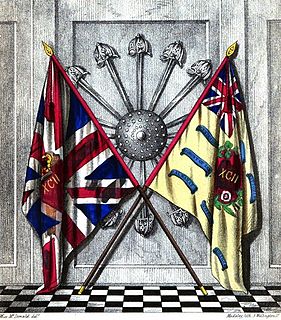
General Sir James Kempt, was a British Army officer, who served in the Netherlands, Egypt, Italy, the Peninsula, and British North America during the Napoleonic Wars. He led a British brigade at the Battle of Waterloo and later became Governor General of Canada.

The Gordon Highlanders was a line infantry regiment of the British Army that existed for 113 years, from 1881 until 1994, when it was amalgamated with the Queen's Own Highlanders to form the Highlanders. Although the 'gordon highlanders' had existed as the 92nd Regiment of Foot since 1794, the actual 'Gordon Highlanders Regiment' was formed in 1881 by amalgmation of the 75th (Stirlingshire) Regiment of Foot and 92nd Regiment of Foot.

Clan Gordon, also known as the House of Gordon, is a Scottish clan. The chief of the clan is the powerful Earl of Huntly, and now also the Marquess of Huntly. During the Wars of Scottish Independence in the 13th century, the Gordons supported William Wallace in the cause of independence. In the 15th century, the chiefship of the clan passed to an heiress, who married into the Seton family and her male descendants assumed the surname Gordon and continued as chiefs of the clan. The Gordons assisted in defeating the rebellion of the Earl of Douglas also in the 15th century. In the 16th century, the Gordons as Catholics feuded with their Protestant neighbors the Clan Forbes and also defeated at the Battle of Glenlivet, the Protestant Earl of Argyll. During the Wars of the Three Kingdoms of the 17th century, the Gordons supported the Royalist cause. During the Jacobite rising of 1715 the Clan Gordon was Jacobite. During the Jacobite rising of 1745, their chief, then the Duke of Gordon, pledged his support to the British-Hanoverian Government, but his clan remained Jacobite.

The 84th Regiment of Foot was a British regiment in the American Revolutionary War that was raised to defend present day Ontario, Quebec and Atlantic Canada from the constant land and sea attacks by American Revolutionaries. The 84th Regiment was also involved in offensive action in the Thirteen Colonies; including North Carolina, South Carolina, Georgia, Virginia and what is now Maine, as well as raids upon Lake Champlain and the Mohawk Valley. The regiment consisted of 2,000 men in twenty companies. The 84th Regiment was raised from Scottish soldiers who had served in the Seven Years' War and stayed in North America. As a result, the 84th Regiment had one of the oldest and most experienced officer corps of any regiment in North America. The Scottish Highland regiments were a key element of the British Army in the American Revolution. The 84th Regiment was clothed, armed and accoutred the same as the Black Watch, with Lieutenant Colonel Allan Maclean commanding the first battalion and Major General John Small of Strathardle commanding the second. The two Battalions operated independently of each other and saw little action together.

The 42nd Regiment of Foot was a Scottish infantry regiment in the British Army also known as the Black Watch. Originally titled Crawford's Highlanders or the Highland Regiment and numbered 43rd in the line, in 1748, on the disbanding of Oglethorpe's Regiment of Foot, they were renumbered 42nd and in 1751 formally titled the 42nd (Highland) Regiment of Foot. The 42nd Regiment was one of the first three Highland Regiments to fight in North America. In 1881 the regiment was named The Royal Highland Regiment , being officially redesignated The Black Watch in 1931. In 2006 the Black Watch became part of the Royal Regiment of Scotland.

The 92nd Regiment of Foot was a British Army infantry regiment, raised in 1794. Under the Childers Reforms it amalgamated with the 75th (Stirlingshire) Regiment of Foot to form the Gordon Highlanders in 1881.

The 72nd Highlanders was a British Army Highland Infantry Regiment of the Line, raised in 1778. Under the Childers Reforms it amalgamated with the 78th (Highlanders) Regiment to form the 1st Battalion of the Seaforth Highlanders in 1881.

The 71st Regiment of Foot was a Highland regiment in the British Army, raised in 1777. Under the Childers Reforms it amalgamated with the 74th (Highland) Regiment of Foot to become the 1st Battalion, Highland Light Infantry in 1881.
Three regiments of the British Army have been numbered the 81st Regiment of Foot:
The 109th (Aberdeenshire) Regiment of Foot was an infantry regiment of the British Army from 1794 to 1795. Raised by Alexander Leith Hay for service in the French Revolutionary Wars the regiment was briefly deployed in Jersey before it was disbanded in England and its men sent to reinforce the 53rd (Shropshire) Regiment of Foot. The disbandment was controversial as Leith-Hay believed it contravened an assurance given to him in his original letter of service to raise the regiment.
The 71st Regiment of Foot was a regiment of infantry raised in 1775, during the American Revolutionary War and unofficially known as Fraser's Highlanders. It was disbanded in 1786.
81st Regiment may refer to:

General William Gordon, of Fyvie, was a British general and courtier. He was several times returned to Parliament by the interest of the Duke of Marlborough, and precipitated a family quarrel with his nephew, the Duke of Gordon, by commandeering a regiment that the latter was raising.
The 74th Regiment of (Highland) Foot or 74th Regiment of Foot was a British Army line infantry regiment from 1777 to 1784 which was raised to fight in the American Revolutionary War.

Gen. Sir Josiah Champagné was a British military commander who was the fifth General Officer Commanding, Ceylon. He was appointed in February 1799 until 1799. He was succeeded by Hay MacDowall.
General Gordon Forbes was a senior officer in the British Army.
General Sir Alexander Leith, KCB was a Scottish officer in the British Army.
The 89th (Highland) Regiment of Foot or Morris's Highlanders was an infantry regiment in the British Army from 1759 to 1765.









